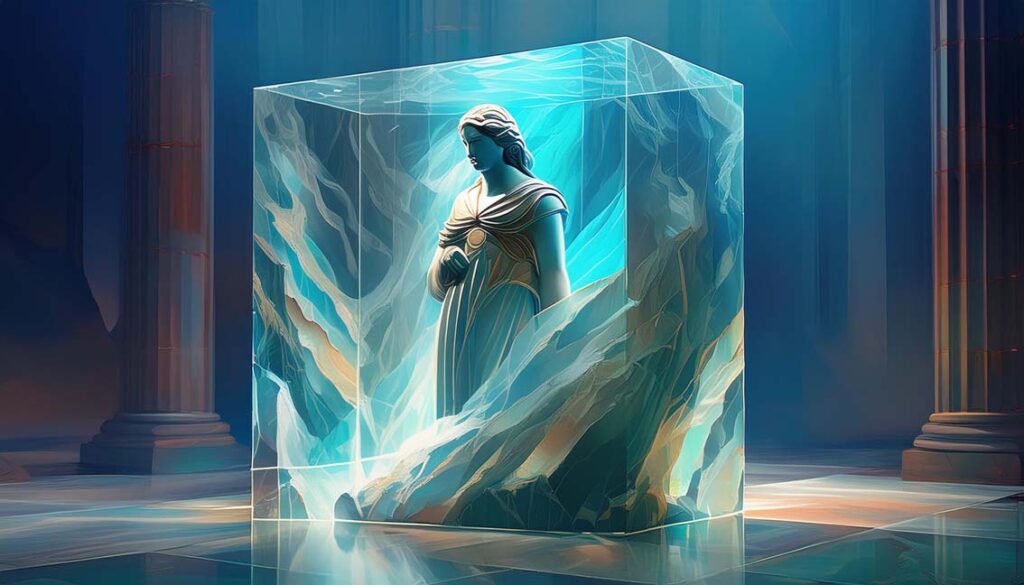The previous presentation examined thought waves. Let us now turn our attention to thought forms. This is the second effect that occurs when a person uses their mental body to think; a physical structure is actually created, which is clearly visible on the mental plane.
As we have learned, when a thought arises, it creates vibrations in the mental body. These vibrations cause a portion of the mental body to separate and take on a specific shape based on the nature of the vibrations, similar to how fine particles on a vibrating surface form patterns in response to sound waves.
The mental matter that is separated attracts elemental essence from the surrounding Mental World and causes that essence to vibrate in harmony with its frequency.
This process results in the creation of a pure and simple thought form. A mental thought form is similar to an emotional form, as described in previous presentations. However, it is more vibrant, colourful, stronger, longer-lasting, and more fully energised.
A graphic description of the effect of thought is as follows: “These mental vibrations shape the matter of the plane into thought forms, giving rise – due to their swiftness and subtlety – to the most exquisite and constantly changing colours. Waves of varying shades, like the rainbow hues in mother-of-pearl, are etherealised and brightened to an indescribable extent. They sweep over and through every form so that each presents a harmony of rippling, living, luminous, delicate colours, including many not even known on Earth. Words cannot give an idea of the exquisite beauty and radiance shown in combinations of this subtle matter, instilled with life and motion. Every seer, whether Hindu, Buddhist, or Christian, speaks in rapturous terms of its glorious beauty and confesses their utter inability to describe it. Words seem but to coarsen and deprave it, however deftly the praise is spoken.”
A thought form is a temporary living entity of intense activity animated by the one idea that generated it. If made of the finer kinds of matter, it will be of great power and energy and may be used as a most potent agency when directed by a strong and steady will. We will discuss the details of such use later.
The elemental essence is a strange semi-intelligent life that surrounds us, vivifying matter of the mental plane. It responds readily to the influence of human thought, so every impulse sent out from a person’s mental body immediately clothes itself in a temporary vehicle of this essence. It is, in fact, even more instantaneously sensitive, if that be possible, to the action of thought than is emotional elemental essence.
The mental elemental essence differs significantly from the emotional elemental essence. It operates on a different level, and its force cannot work in the same concentrated way. This essence is largely responsible for our wandering thoughts, which constantly shift from one thing to another.
When we think of a thought, it temporarily becomes a living creature; the thought force is like the soul, while the elemental essence is like the body. These thought forms are called elementals or sometimes artificial elementals.
The principles underlying the production of all thought forms are:-
(1) Quality of thought determines colour
(2) Nature of thought determines the form
(3) Definition of thought determines clearness of outline.
Thought forms can come in a wide range of colours and shapes. The significance of these colours aligns with those found in the emotional and mental bodies, as previously described in the series on the Emotional Envelope and in earlier presentations of this series.
For example, feelings of affection create a glowing rose-colored thought form, a desire to heal produces a lovely silvery-white one, and a mental effort to stabilise and strengthen the mind results in a beautiful flashing golden-yellow thought form. Yellow in any of the vehicles always indicates intellect, but its shades can vary greatly and may be influenced by the presence of other colours.
It’s important to remember the following: “In general, a thought form appears with a deeper and duller colour when it is directed towards selfish purposes, especially in lower channels. In the emotional or mental body of a typical businessperson, it would appear as yellow ochre, while pure intellect focused on philosophy or mathematics often appears as golden. This golden colour gradually becomes a beautiful, clear, and luminous primrose-yellow when a powerful intellect is used selflessly for the benefit of humanity. Most yellow thought forms have clear outlines; a vague cloud of yellow is relatively rare. This colour indicates intellectual pleasure, such as an appreciation of ingenuity or the delight in clever craftsmanship.”
A cloud of this nature indicates the complete absence of any personal emotion; as if it were present, it would inevitably colour the yellow with its appropriate hue. In many cases, thought forms are simply revolving clouds of colour relevant to the idea from which they originated. The student will understand that, at this current stage of humanity, there is a vast predominance of cloudy and irregularly shaped thoughts, the result of the untrained minds of the majority. It is one of the rarest phenomena to observe clear and definite forms among the thousands that surround us.
Where a thought is clear and definite, a form is created, often taking on a beautiful and distinct shape. While these shapes come in infinite varieties, they often reflect the nature of the thought they represent. Abstract ideas typically take on perfect and beautiful geometric forms. It’s important to note that even the most abstract concepts for us become concrete realities on the mental plane.
The strength of thought and emotion determines the size and duration of the thought form as a separate entity. How long it lasts depends on the nourishment it receives through the repetition of the thought, either by its creator or by others.
If the thought is intellectual and impersonal –eg. If the thinker is attempting to solve a problem in algebra or geometry –then the thought forms (as well as the thought waves) will be confined to the mental plane.
When someone’s thoughts are of a spiritual nature, such as being filled with love and deep, unselfish feelings, then these thoughts will rise upwards from the mental plane and take on the splendour and glory of the levels above. In such cases, their influence is very powerful and each of these thoughts becomes a strong force for good.
Conversely, if a thought is tinged with self-centredness or personal desires, its vibrations turn downwards. It then attracts emotional matter in addition to its mental clothing, forming what is more accurately termed a thought-emotion form. This type of thought can affect the mental and emotional bodies of other people.
The most common thought form is one that is influenced by desire, passion, or emotion, as very few thoughts of ordinary people are free from these influences. This class of thought forms is considered to be generated by the activity of kama-manas, which means mind dominated by desire.
When a person thinks of any specific object, like a book, a house, or a landscape, they create a small mental image of the object in the matter of their mental body. This image appears in the upper part of their mental body, usually in front of their face and at the level of their eyes. It remains there as long as the person is thinking about the object, and usually for a short time afterwards, depending on the intensity and clarity of the thought. This form is quite objective and can be seen by another person with mental clairvoyance. If a person thinks of another person, they create a small portrait in the same way.
The same result follows any effort of the “imagination.” A painter who envisions a future picture constructs it using the material of their mental body and then projects it into space in front of them. They keep the image in their mind’s eye and reproduce it. Similarly, a novelist forms mental images of their characters and moves them around using their will, so that the plot of the story is acted out before them.
As mentioned earlier, these mental images are so objective that they can not only be seen by a clairvoyant but can also be manipulated by someone other than their creator. For example, mischievous nature spirits or often a deceased novelist observing the work of their fellow author may move the images or characters, making it seem as if they have developed a will of their own. Consequently, the plot of the story unfolds in a way different from what the author had originally intended.
A sculptor makes a strong thought form of the statue they intends to create, plants it in their block of marble, and then proceeds to cut away the marble which lies outside the thought form until only that portion of it which it interpenetrated by the thought form remains. Similarly, a lecturer creates strong thought forms as they deeply contemplate different aspects of their subject. If the audience doesn’t understand, it’s likely because the lecturer’s own thoughts are not clear enough. A vague thought form makes little impact, while a well-defined one compels the audience to engage with it.
In the next presentation, we will look at how hypnotists use thought forms.


